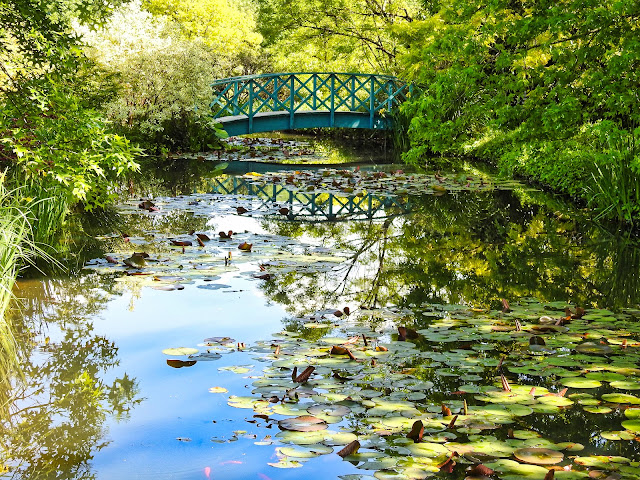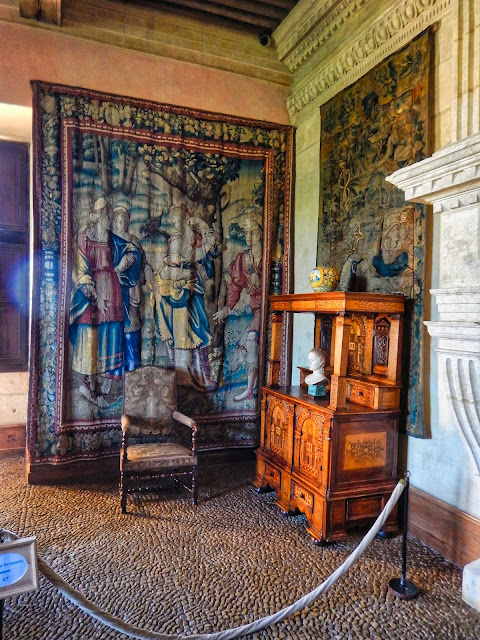Les Jardins d'Eau de Carsac-Aillac
On a very, very hot day we sought refuge in the Water Gardens of Carsac-Aillac. This unique garden sits on the edge of the Dordogne River and was only created in 1999. Having tromped up and down hills through acres of boxwood topiaries, this garden provided a nice counterpoint. The gardens boasted the remains of a Roman aqueduct which irrigated the area from 27 BC to 480 AD. The water lilies here could give Giverny a run for their money. Perhaps the most interesting aspect was a water lily maze. But, for gardens, pictures really tell the tale best.
 |
| The number of water lilies and variety were astounding, as can be seen from the photos. |
 |
| These rhododendron had just come into bloom. |
 |
| Even this lily pads made for an interesting photo, with the water droplets resting on top. |
 |
| Some of the flowers other than the water lilies were also spectacular. |
 |
| There was also a large water tank with all of these colorful carp. |
 |
| Deirdre revelled in the wisteria. |
 |
| This is a section of the water maze with a fountain. You can see some portions of the maze were slightly under water. |
 |
| Where there are lily pads, there are frogs with some partially on the lily pad... |
 |
| others fully resting on the lily pad... |
 |
| and some shy ones hiding under the lily pad. |
 |
| Another beautiful wisteria (of which Deirdre could not get enough throughout the trip). |
Kayaking on the Vezere
Water is everywhere in the Dordogne region. In addition to the Dordogne river itself, several smaller rivers and/or tributaries run through the valleys creating both lush farmland and endless recreational options. So, off we set to kayak on the Vezere before tackling the larger Dordogne. We rented a double kayak so that Michael could do all the work and I could labor with the taxing duties of reading the very brief, waterproof guide aloud while soaking in the sun and scenery. I will not belabor this with more verbiage than it warrants. Just check out the view from the kayak as we drift downstream. Michael noted that having a current carry you is significantly easier than kayaking on the lake.
 |
| All along the kayak trip we encountered limestone caves. |
 |
| You can see where wood posts were once stuck into the limestone on this one. |
 |
| In some areas the limestone cliffs loomed over the river. |
 |
| Here Deirdre is reading from the guide as I paddle along. |
 |
| These trees were in full flower, with many of the flowers drifting down into the river. |
 |
| There were also many sea grass mats which were covered in flowers as well. |
 |
| Here is where a house has been built into the cliff... |
 |
| with a large cavern next to the house. |
Back on Dry Land Attending to Necessities
Eventually you have to do laundry. It is a fact of life. When we first ventured to Europe decades ago you needed a physics degree or a magician to figure out the workings of European laundry machines. I once spent 7 hours in a sweltering basement in London attempting to coax the machine to bring forth clean, dry clothing. Well, things have changed! Now there's the Euro. Now borders are transparent. Now laundry machines make sense and instructions are in French AND English. They even take credit cards! Eureka! So, faced with heaps of dirty clothes we went to Brugge and were lucky to learn that it was market day. We zipped the laundry into the washers and headed to the market. On the way, we noted people craning over the side of a walkway paralleling the River (Dordogne). There was a significant drop and I wondered if someone had taken the plunge. But no. They were admiring the most gorgeous Iris I have ever seen in my life. After oohing and ahhing and photoing we went on to the market-- which was terrific. We were done with our shopping and coffee sipping just in time to retrieve the laundry. So, we went on to lunch.
 |
| We parked across the river, then walked over the bridge to get to the market. The parking lot was very close to the laundromat, which made our lives a lot easier. |
 |
| Just below the parking lot on the bank of the river we saw this amazing collection of a variety of iris. |
 |
| The Le Bugue market had these colorful butterflies strung up above the market. In another market town they had colorful ribbons. |
 |
| The first thing we encountered were all of the food stalls, each specializing in different foods. This one had all things seafood... |
 |
| while this one had everything to do with olives. |
 |
| And it wouldn't be France if there weren't one market stall dedicated to wine. |
 |
| French markets are similar to Mexican markets in terms of the variety of items available for purchase, such as items of clothing... |
 |
| such as dressses,... |
 |
| hats,... |
 |
| perfumed soaps,... |
 |
| and even cookware. |
St. Leon Sur Vezere
Back to the water again -- or adjacent to the water. This is a sweet little town very close to where our gite was. We wandered for a while and then lunched at a delightful terraced restaurant. Not much else to say.
 |
| The the town had this church with the three round towers,... |
 |
| and this interesting carved wooden head. |
Chateau de Losse
Early on during we trip we had passed a Chateau that hovered over the Vezere and looked intriguing. One afternoon when we had not yet packed our activities to the hilt we decided to make a visit. This chateau, like a number of others, belonged to a private (wealthy) family who had provided the initial money to renovate it from ruins. Now, they lived on the upper floors of the chateau and allowed the public to come and enjoy it. All admission fees go to the further enhancement of the Chateau. I would suggest they use our contribution for better signage as we traipsed from pillar to post attempting to follow a theoretical "route guidee". But it was very pretty.....
 |
| The gatehouse of the chateau... |
 |
| with this interested carved saying above the entrance. Translated it reads: "Man does what he can. Fortune does what it wants." |
 |
| The chateau from a corner of the courtyard garden. |
 |
| The chateau had a moat surrounding it on three sides and the Vezere river on the fourth side. |
 |
| This door knocker may have been adapted from the families coat of arms. |
 |
| This ornately carved bed was a bit too narrow for our tastes. |
 |
| One noted feature throughout the chateau was the number of tapestries. The one behind the desk is rather small compared to the other ones in the chateau. |
 |
| The reception room featured a capacious fireplace and damask covered chairs. |
 |
| The following photos will show the number of old tapestries (many in excellent condition) adorning the walls of the chateau. |
 |
| A fountain in the garden... |
 |
| and gardeners tending to the gardens around the chateau. |
 |
| This criss-crossed hedge pattern was one of the more intriguing things in the garden |
 |
| This is a better view of the sea grass with flowers that we saw on the Vezere and the Dordogne Rivers. |
Back to the Dordogne and the La Roque-Gageac
By now you have noticed that almost every place we have visited or activity we have enjoyed has been on or adjacent to one of the rivers within the Dordogne. La Roque-Gageac is no exception. Settlers have always gravitated to rivers as they provide food, water, transportation and some level of defense. La Roque-Gageac is much like the Roque Christophe which we visited earlier but where Christophe eventually ceased to shelter a population, La Roque-Gageac has never ceased to support a population from prehistoric times to the present. The town boasts a semitropical microclimate which allows banana trees and other species usually seen in warmer climes to thrive here. We climbed to the fort (I was actually almost getting used to these climbs) but when I saw the additional zillion stairs to explore the fort I rebelled. Michael barely put up a protest. We were wearing down....
 |
| You can see Deirdre's finger pointing the the stairs in the lower right of the photo. She is saying "No way am I going to climb those stairs." |
 |
| The limestone cliff not only needed these supports, but the wire mesh was put in place to prevent the rocks from falling on the houses and villagers below. |
 |
| This church... |
 |
| and these buildings and houses were well below the wire mesh. |
 |
| Even though the church was small, it had a bell tower... |
 |
| and the arched inside was quite charming. |
 |
| Because the town is protected by the cliff and is south facing, many interesting flora thrives here. |
 |
| Many of these plants would not be out of place in Mexico. |
 |
| This store was built into the cliff face, with the limestone cliff as the back wall. |
 |
| I hiked up higher on a path which took me above the slightly lower part of the town in order to capture this photo of the river... |
 |
| and Castlenaud in the distance. |
Down but Not Dead Yet
The next blog takes place (mostly) on dry land. We will spend an afternoon with wild boars, visit a major Buddhist Retreat, drop into Brantome (absolutely the most beautiful of all the beautiful villages) and Terrasson and end with a kayak down the Dordogne. We'll finish up with our quick trip to Madrid. So, hang in there. We're on the home stretch.....






















































































I just love your travels! This was one of my favs
ReplyDeleteLove the Dordogne, you two are amazing and so adventurous x
ReplyDeleteFabulous photography.
ReplyDeleteGreat photos and commmentary!
ReplyDeleteThe both of you - zo a
ReplyDeleteSo well done. Thank you. Enjoy.
ReplyDeleteWhat splendid photos! Makes me want to do an only Dordogne trip. I now realize how little of it I actually saw.
ReplyDeleteMany thanks for sharing.
Photography and write-up were amazing!! Glad you are enjoying the good life!
ReplyDelete